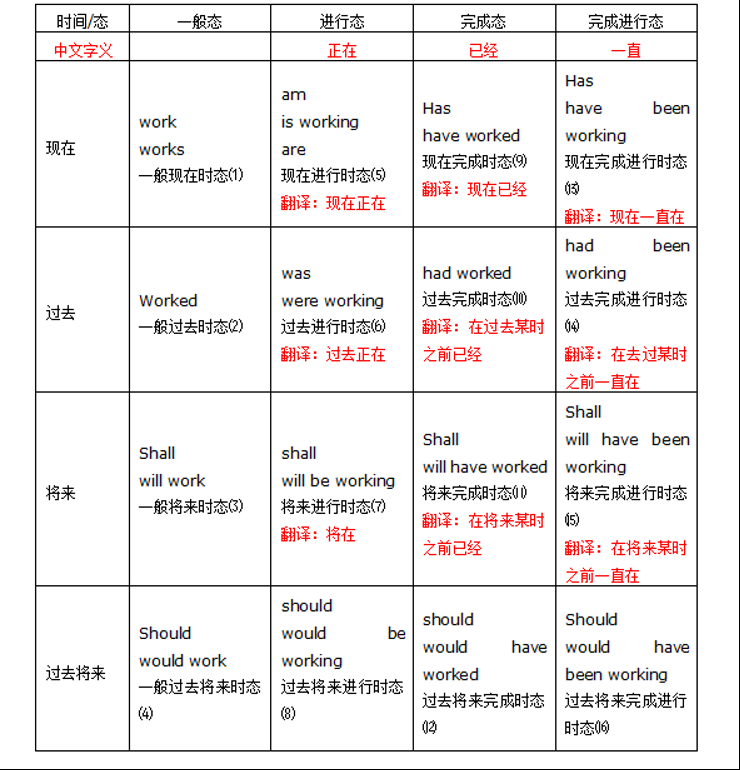
| –1.had done– | 过去 | –2.have done– | 现在 | –3.will have done– | 将来 | –> |
| –1.had been doing– | 过去 | –2.have been doing– | 现在 | –3.will have been doing– | 将来 | –> |

构成:had + 过去分词
过去完成时主要用于表示两个事件中一个发生在前,或者说是表示较早的过去。常与现在完成时连用的副词,如 already(已经),ever(曾经),for + 表示时间段的词,just(刚刚) 和 never(从未) 也常与过去完成时连用,以强调事件发生的先后次序。有时我们不一定非得用过去完成时表示先发生的事件,因为意思十分清楚。
After I finished, I went home.
我做完后就回家。
请看例句:
She went on holiday after she had taken the exam. 她考试后度假去了。
I ran to the platform quickly, but the train had already left.
We had had dinner before they arrived.
The patient had died when the doctor arrived.
http://www.douban.com/group/topic/17169041/ 动词过去式变化规则及其读音规则 lesson 67-68
(1) 一般过去式1 be(am/is/are) 的过去式是 was/were: wasn’t 和 weren’t
在英文中,过去发生的而现在已经结束的动作要用一般过去时来表示。be 动词的过去式不规则。
Where were you on Sunday? I was at church on Sunday.
When was he absent from school? He was absent on Monday, Tuesday, Wednesday and Thursday.
(2) 一般过去式2 (3) 过去式采用的时间 the other + 表示时间的名词通常只与过去时态连用.类似的短语有 the other morning/afternoon/evening/night/week/month/yeat
构成:be 的过去式 + 现在分词 过去进行时表示过去某时正在进行的情况和动作。过去进行时和一般过去时经常在同一个句子里使用。过去进行时表示过去正在进行的情况和动作,一般过去时则表示比较短暂的动作或事件。过去进行时的时间状语从句一般由 when, while及(just) as 等来引导,说明从句中动作发生时的背景。此外,可用 while 或 at the time 等强调同时进行的两种或几种动作。请看例句:
When I was doing the housework, my husband telephoned me from the office.
While I was listening to the stereo, my mother came into the room.
Just as she was cleaning her shoes, George knocked at the door.
While I was cooking the dinner, he was working in the garden.
(1) 在英语中,现在完成时主要用于以下两种情况: A.表示在过去不确定的时间里发生的并与现在有着某种联系的动作; B.表示开始于过去并持续到现在的动作,在这种情况下,它一般与 for + 一段时间、since + 某个时间点连用。 如:
How long has Ian lived in the house? He's lived here for twenty years.
Since when has he been there? Since 1976.
(2) 现在完成时在汉语中常用“了”、“过”、“已经”来表示。
(3) 现在完成时由 have/has + 过去分词构成,单数第3人称用 has,其他人称皆用 have。规则动词的过去分词与过去式相同,而不规则动词的过去分词则无统一的规律可言,需特别加以记忆。
(4) 现在完成时通常与表示不确定的时间副词或短语连用,如 just, already, before, never, ever, twice, three times 等。
(5) 现场完成时的构成是 have/has + 过去分词,因此其疑问式是将 have/has 提到主语之前,否定式则在 have/has 后加上 not 即可。
例句:
I have already had lunch.
I have not had lunch.
have you had lunch?
has she had any beans or peas?
What have they just done? They have just made their beds.
描述经常发生的动作和经常存在的状态。我们用一般现在时态。往往与频度副词连用, 如 often, always, sometimes, never等。
every day ; in the evening ; in the morning;
always ; often; usually ;
What do/does ... usually do?
They always go to school in the morning.
She stays at home evrey day.
He often reads his newspaper in the evening.
She always eats her lunch at noon.
She ususlly sees her friends in the afternoon.
At night, the children always do their homework. Then they go to bed.
When does he usually shave every day?
He usually shaves at seven o'clock.
在用一般现在是询问有关习惯的问题时可用ever:
Do you ever catch a cold in the winter? Yes, I caught a cold last winter.
Do you ever play tennis at the weekend? Yes, I played tennis last weekend.
在英文中若想表达此刻正在进行的动作或事件,要用动词的现在进行时形式。往往与 now, just, still 等副词联用
be + 现在分词
What's he/she/it doing
He / She / It is ...
What's Steven doing?
He is reading a newspaper.
What is she doing this morning?
She is drinking tea this morning.
John is still sleeping.
Jane is just dressing up.
Mrs. Smith is cooking now.
1.read --> reading; cook-->cooking
一般的现在分词直接在动词后面加 ing 即可。
2. make --> making; take --> taking
以不发音的 e 结尾,去掉 e +ing
3. sit --> sitting; shut --> shutting
以辅音字母结尾,前面只有一个原因,则重写最后字母 +ing
将助动词提前
He is reading a magazine.
Is he reading a magazine.
将 not 放在助动词之后 The dog is drinking its milk. The dog is not drinking its milk.
一般将来时表示将来某一时刻的动作、状态以及打算。该时态一般与表示将来意义的时间状语连用, 如 tomorrow, this month, the day after tomorrow, next week, in two days’s time(两天之后), from now on(从现在开始), in the future(将来) 等。
will 可用于所有人称,但 shall 仅表示单纯将来时用于第一人称 I 和 we,作为 will 的一种替代形式。否定缩写:shall not=shan’t will not=won’t.此外,will 除了表示纯粹的将来时间外,还表示说话人的意图和意愿,而 shall 除了表示将来时间外同时还表示说话人的责任和决心。
在口语中,be going to 比 will/shall 更为普通, 用来表示说话人的打算和意图。如:She is going to travel by air.她打算乘飞机旅行。
也可以用来表示有迹象某事即将发生。如:It’s going to rain.将要下雨了
将来时 be going to 的形式由 am/is/are going to + 动词原形构成。 用法 表示“打算”、“准备”在最近做某事。(在非正式语体中,一般多用 be going to, 而不用 will)。
I am going to put it on the floor.
我打算把它放在地板上。
He is going to paint the bookcase tomorrow.
他准备明天给书架刷漆。
表示按计划、安排要发生的事:
The meeting is going to begin at nine.
会议将在 9 点开始。
Where are you going to build the road?
你们将在什么地方筑路? 表示语言一件事即将发生:
The meeting is going to begin at nine.
It's going to rain!
She's going to faint. **疑问句与否定式**
将助动词 be 提至句首可将陈述句变为一般疑问句。如:
George is going to paint the pink. ==> Is George going to paint it pink? 在助动词后面加上 not 可以得到否定句。如上句可变为:
George is not going to paint the pink. ### 10.4 可与将来时连用的时间状语。
今天:
this morning/afternoon/evening/tonight 今天上午/下午/晚上/今夜
明天:
tomorrow morning/afternoon/evening 明天上午/下午/晚上
后天:
the day after tomorrow 后天
the night after next 后天夜里
其他:
in the morning 在上午
in the afternoon 在下午
in the evening 在晚上
this week / next week / the week after next (这周、下周、下下周),这里week 可以换成 year,month 等。
in a day's time/ in two weeks' time / in three months' time (3个月后) 等等。
1、一般情况下,动词词尾加 -ed ,如:
work ---worked play---played wanted----wanted act----acted
2、以不发音的 -e 结尾动词,动词词尾加 -d,如:
live---lived move----moved taste---tasted hope---hoped
3、以辅音字母 + y结尾的动词,把-y变为-i 再加-ed,如:
study---studied copy---copied cry---cried carry---carried
4、以一个辅音字母结尾的重读闭音节动词,双写词尾辅音字母,再加 -ed,如:
stop ---stopped
5、不规则动词的过去式变化规律性不强,须多加记忆。
go – went make – made get – got buy - bought come - came fly-flew
1.把动词原形中的i改为a,变成过去式。如:
begin—began,drink—drank,give—gave,ring—rang,sing—sang,sit—sat,swim—swam
2.把重读开音节中的i改为o,变成过去式。如:
drive—drove,ride—rode,write—wrote
3.改动词原形中的aw /ow为ew,变成过去式。如:
draw—drew,grow—grew,know—knew,throw—threw(动词show除外,show—showed)
4.动词原形中的e改为o,变成过去式。如:
get—got,forget—forgot
5.动词原形中的ee改为e,变成过去式。如:
feed—fed,meet—met
6.动词原形中的eep改为ept,变成过去式。如:
keep—kept,sleep—slept,sweep—swept
7.动词原形中的eak改为oke,变成过去式。如:
break—broke,speak—spoke
8.动词原形中的ell改为old,变成过去式。如:
sell—sold,tell—told
9.动词原形中的an改为oo,变成过去式。如:
stand—stood,understand—understood
10.以ought和aught结尾,且读音是〔 :t〕的过去式。如:
bring—brought,buy— bought,think—thought,catch—caught,teach—taught
11.以ould结尾且读音为〔ud〕的情态动词过去式。如:
can—could,shall—should,will—would
12.把动词原形中的o改为a,变成过去式。如:
come—came,become—became
13.在动词原形后加d或t变成过去式,并且发生音变。如:
hear〔hi 〕—heard〔h :d〕, say〔sei〕—said〔sed〕,mean〔mi:n〕—meant〔ment〕
14.动词的过去式与动词原形一样。如:
let—let,must—must,put—put,read—read〔red〕
15.不符合上述规律的动词过去式。如:
am,is—was,are—were,build—built,do—did,eat—ate,fall—fell,feel—felt,find—found,fly—flew,go—went,have /has— had,hold—held,leave—left,make—made,may—might,run—ran,see—saw,take—took ### 附录3:过去式“-ed”的发音规则
(1)动词词尾为“t,d”时,发/ id /音,
want →wanted (要)need →needed (需要)
(2)动词词尾为清辅音时,发/ t / 音。
help →helped (帮助)laugh →laughed (笑)look →looked (看)
kiss →kissed (吻)wash →washed (洗) watch →watched (注视)
(3)动词词尾为t,d以外之浊辅音或元音时,发/ d /音。
call →called (叫)stay→stayed (停留)cry→cried (哭));